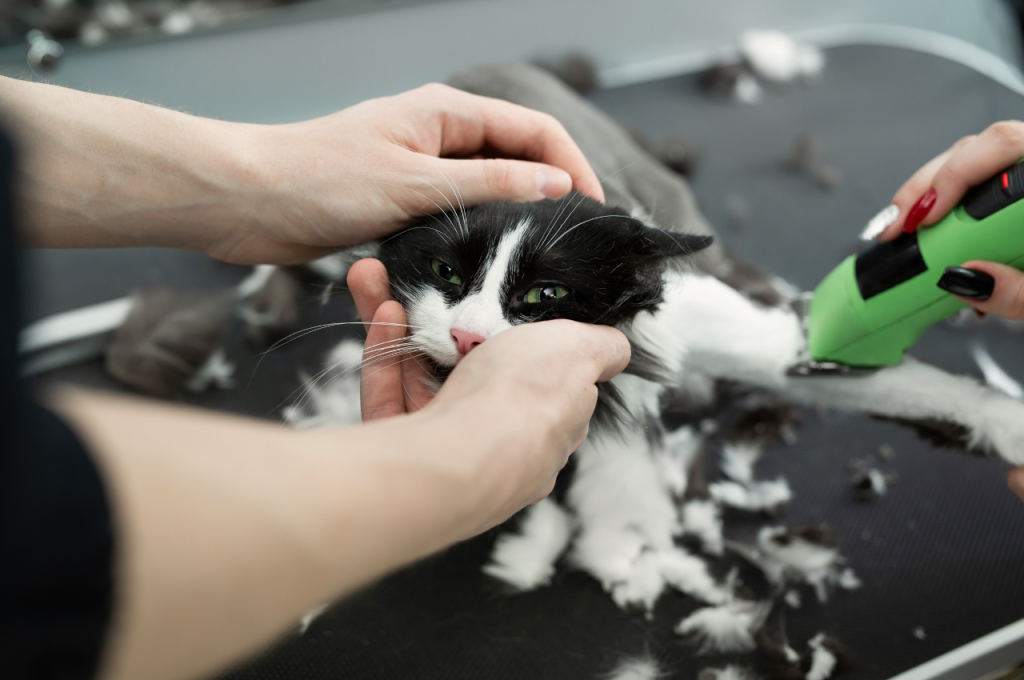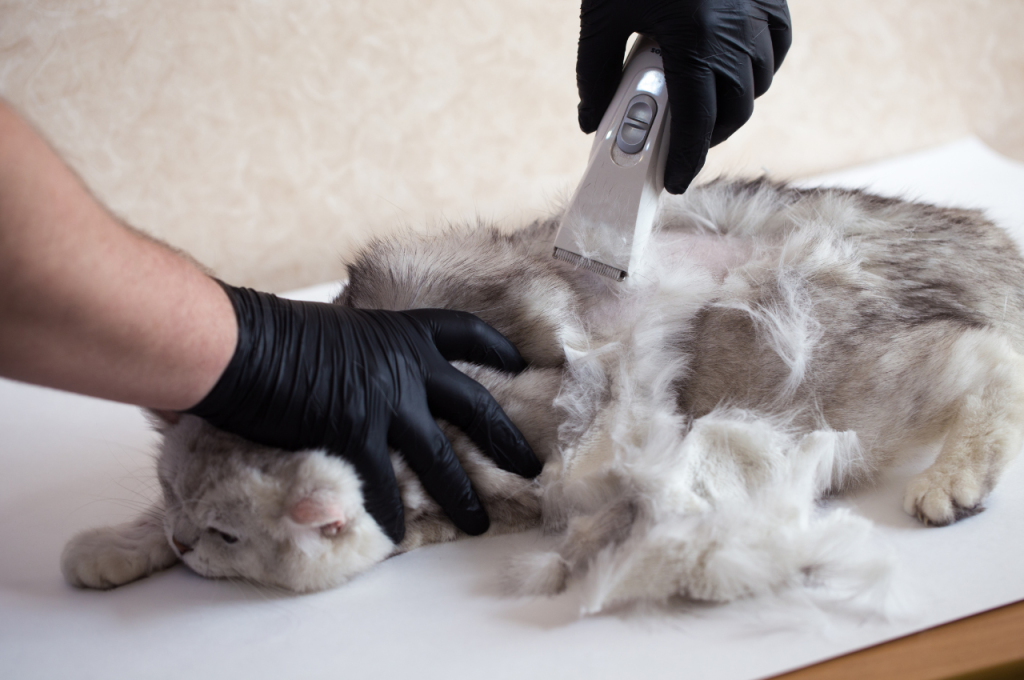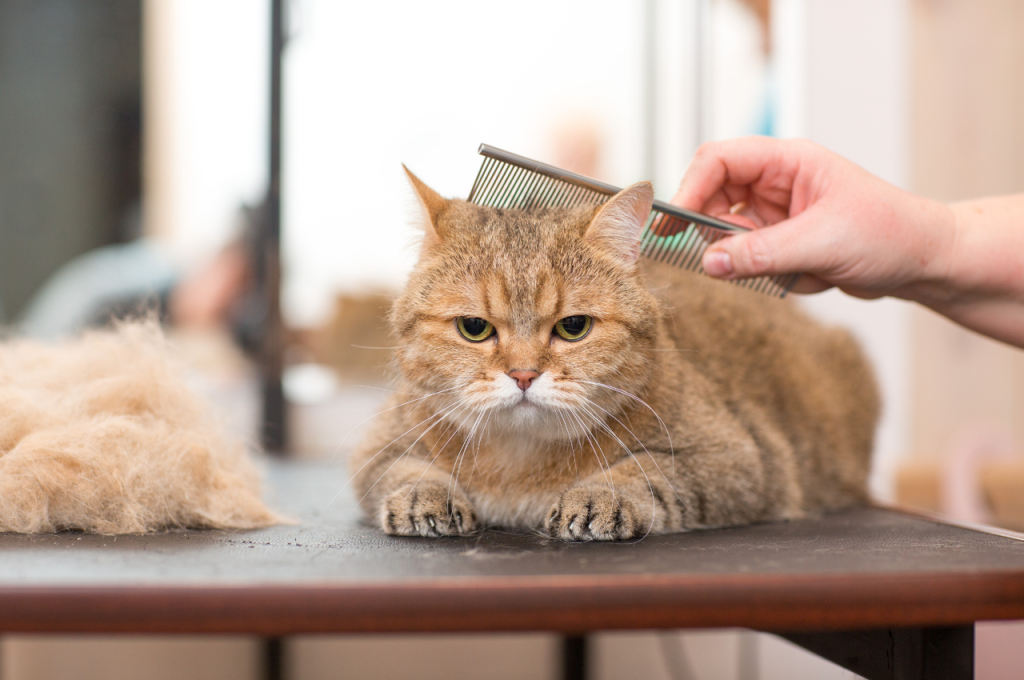To shave a cat, use pet-specific clippers, start at the neck, and work towards the tail in gentle strokes. Shaving a cat requires caution and patience to avoid cuts and stress.
Always prioritize the cat’s safety and comfort during the grooming process. Regular grooming helps prevent matting and keeps the cat’s fur healthy and clean. Proper tools and techniques are essential for a successful and stress-free shaving experience for both the cat and the owner. Now, let’s explore the step-by-step process of shaving a cat in a safe and effective manner.
Introduction to Cat Grooming
Discover the essential steps for shaving a cat to ensure a safe and stress-free grooming experience. Proper preparation and gentle handling are key to achieving a smooth and even shave, helping your feline friend stay comfortable and well-groomed.

Cats are known for their self-grooming habits, but sometimes they may need some help from their human owners. Grooming your cat not only helps to keep them looking their best, but it also promotes good health. Proper grooming can help to prevent hairballs, skin irritations, and other health problems. In this post, we will focus on shaving a cat and when it might be necessary. But before we dive into the details of shaving, let’s take a look at the importance of proper cat grooming.
The Importance of Proper Grooming
Proper grooming is essential for your cat’s health and well-being. Regular grooming helps to remove loose hair and dirt, which can prevent matting and tangling of the fur. It also promotes better circulation and can help to prevent skin irritations. Grooming can also help to reduce hairballs, which can be a common problem for cats who shed a lot. Additionally, grooming can help you bond with your cat and can be a relaxing and enjoyable experience for both of you.
When Shaving Might Be Necessary
Shaving a cat is not something that should be done lightly. In fact, most cats do not need to be shaved at all. However, there are some situations where shaving might be necessary. For example, if your cat has a lot of mats or tangles in their fur, shaving may be the only option. Mats and tangles can be painful for your cat and can also lead to skin irritations. Shaving can also be necessary if your cat has a skin condition that requires treatment or if your cat is prone to overheating in the summer months. If you are unsure whether your cat needs to be shaved, it is best to consult with a professional groomer or your veterinarian.
In conclusion, proper grooming is essential for your cat’s health and well-being. Shaving a cat should only be done in certain situations and should be done with care. By understanding the importance of grooming and when shaving might be necessary, you can help keep your cat healthy and happy.
Understanding Your Cat’s Skin and Coat
Knowing how to shave a cat safely is crucial for their well-being. Begin by using pet-safe clippers, ensuring your cat is calm and relaxed. Shave in the direction of hair growth to avoid irritation. Always be gentle around sensitive areas and consult a vet if unsure.
Anatomy of Feline Fur
Cats have a remarkable coat that consists of three layers: guard hair, awn hair, and down hair. The guard hair is the outer layer that provides protection, while the awn hair gives volume, and the down hair offers insulation.
Recognizing Skin Sensitivities
Cats can experience various skin sensitivities, such as allergies, parasites, and infections. It’s important to observe any changes in your cat’s skin, such as redness, itching, or flakiness, which may indicate an underlying issue.
Preparing for The Shave
Shaving a cat can be a challenging task, but with proper preparation, it can become a stress-free experience for both you and your furry friend. Before you begin the shaving process, it’s important to make sure you have everything you need and create a calm environment to keep your cat relaxed. In this section, we will discuss two crucial aspects of preparing for the shave: choosing the right tools and creating a calm environment.
Choosing The Right Tools
When it comes to shaving a cat, using the right tools is essential to ensure a safe and efficient grooming session. Here are some key tools you should consider:
- Electric Clippers: Invest in a good quality, quiet electric clipper specifically designed for pet grooming. Look for clippers with multiple blade options to cater to different fur lengths.
- Clipper Blades: Depending on your cat’s fur length, choose the appropriate clipper blade size. A shorter blade is suitable for thicker coats, while a longer blade is ideal for lighter fur.
- Grooming Scissors: Have a pair of blunt-tipped grooming scissors handy to trim hard-to-reach areas or delicate spots.
- Comb or Brush: Before shaving, use a comb or brush to remove any tangles or mats. This will make the shaving process smoother and more comfortable for your cat.
- Grooming Table or Mat: Consider using a grooming table or non-slip mat to provide a stable surface for your cat during the shave.
Creating a Calm Environment
Creating a calm and soothing environment is crucial to keep your cat relaxed throughout the shaving process. Here are some tips to create a stress-free atmosphere:
- Choose a Quiet Room: Find a quiet room in your house where you can perform the grooming session without distractions or loud noises.
- Use Soft Lighting: Dim the lights or use natural light to create a calming ambiance. Bright lights can make your cat feel anxious or uncomfortable.
- Play Soothing Music: Soft, gentle music can help soothe your cat’s nerves and create a peaceful atmosphere.
- Keep the Temperature Comfortable: Ensure the room is at a comfortable temperature to prevent your cat from feeling too hot or too cold during the shave.
- Provide Familiar Scents: Place a familiar blanket or toy near your cat to provide a sense of security and familiarity.
By choosing the right tools and creating a calm environment, you are setting the stage for a successful and stress-free cat-shaving experience. Remember to approach the shaving process with patience and care, ensuring the safety and well-being of your feline companion.
Step-by-step Shaving Guide
Shaving your cat may seem like a daunting task, but with the right approach and a gentle touch, it can be a stress-free experience for both you and your furry friend. In this step-by-step shaving guide, we will walk you through the process, from initial fur trimming to the actual shaving process, ensuring your cat stays comfortable throughout.

Initial Fur Trimming
Before diving into the shaving process, it’s essential to trim your cat’s fur to a manageable length. This step not only makes the shaving process easier but also helps prevent any accidental cuts or nicks. Here’s how you can trim your cat’s fur:
- Ensure your cat is calm and relaxed before starting. Find a quiet, comfortable space where you can work without distractions.
- Using a pair of pet grooming scissors, carefully trim any knots or mats in your cat’s fur. Be cautious not to pull or tug at the fur, as this can cause discomfort to your cat.
- Next, trim the fur around your cat’s face, ears, and paws. Take extra care around sensitive areas, such as the eyes and paw pads.
- Continue trimming the fur on your cat’s body, working in small sections. Use gentle, short strokes to achieve an even length throughout.
- Remember to pause frequently and offer treats or praise to keep your cat relaxed and cooperative.
The Shaving Process
Once you have trimmed your cat’s fur to a suitable length, you can proceed with the shaving process. It’s crucial to approach this step with caution and prioritize your cat’s comfort and safety. Follow these steps:
- Prepare your shaving tools, including a pet-safe electric clipper with a fresh blade, a towel or mat for your cat to sit on, and a brush to remove loose hair.
- Gently brush your cat’s fur to remove any loose hair and ensure a smooth shaving experience.
- Start the shaving process by working from the neck towards the tail, moving in the direction of hair growth. Use slow, steady strokes to avoid causing any discomfort to your cat.
- Take extra care around sensitive areas, such as the belly, groin, and armpits. These areas may require more attention and a lighter touch.
- Remember to regularly clean the blade and remove any hair buildup to maintain optimal cutting efficiency.
By following this step-by-step shaving guide, you can ensure a safe and comfortable shaving experience for your cat. Remember to always prioritize your cat’s well-being and offer plenty of reassurance and treats throughout the process. Happy grooming!
Handling Your Cat During Shaving
When it comes to shaving your cat, it’s important to handle them carefully to avoid injuries. Begin by brushing their fur to remove any tangles, and use clippers specifically designed for pets. Keep the shaving sessions short, and reward your cat with treats and praise.
Techniques for Restraint
When preparing to shave your cat, use gentle yet firm techniques for restraint to keep your cat safe.
Maintaining Your Cat’s Comfort
Ensure your cat is comfortable during the shaving process by following these tips:
- Provide a quiet and calm environment.
- Gently stroke your cat to soothe them.
- Take breaks if your cat seems stressed.
Post-shave Care
Proper post-shave care is essential after grooming your cat to prevent irritation and infections. Gently clean the shaved area with a pet-safe solution and monitor for any signs of discomfort or redness. Remember to provide a calm and soothing environment for your cat post-shave.
After successfully shaving your cat, it’s vital to follow up with proper post-shave care. This will help soothe your cat’s skin and prevent any complications that may arise from the shaving process. In this section, we’ll explore some essential post-shave care tips, including soothing the skin and monitoring for complications.
Soothing The Skin
After shaving your cat, you may notice some redness or irritation on their skin. To soothe their skin, you can apply a gentle, fragrance-free moisturizer. Be sure to avoid any moisturizers that contain alcohol or other harsh chemicals that could further irritate their skin. You can also use a cool compress to help reduce any inflammation.
Monitoring for Complications
It’s essential to monitor your cat’s skin for any complications that may arise after shaving. Keep an eye out for any signs of infection, such as redness, swelling, or discharge from the skin. Also, monitor your cat’s behavior for any signs of discomfort or distress, such as excessive licking or scratching. If you notice any of these symptoms, it’s crucial to seek veterinary care as soon as possible. In conclusion, proper post-shave care is essential to ensure your cat’s skin stays healthy and irritation-free. By following these tips on soothing the skin and monitoring for complications, you can help your cat stay comfortable and healthy after their shave.
Alternatives to Shaving
When it comes to grooming your furry friend, there are alternatives to shaving that can keep your cat looking and feeling great. Not all cats need to be shaved, and there are other options to manage their fur and maintain their coat health.

Regular Brushing and Combing
Regular brushing and combing are essential for keeping your cat’s coat in good condition. This helps to remove loose fur, prevent matting, and distribute natural oils throughout the coat. It can also reduce shedding and minimize the formation of hairballs. Establishing a consistent grooming routine can help your cat stay comfortable and reduce the need for shaving.
Professional Grooming Services
Professional grooming services can provide expert care for your cat’s coat. Groomers have the skills and tools to perform thorough grooming, including trimming and shaping the fur without the need for shaving. They can also address specific coat issues and provide personalized care based on your cat’s breed and coat type.
Frequently Asked Questions
Here are commonly asked questions about how to shave a cat:
How Do I Shave My Cat at Home?
To shave your cat at home, follow these steps:
- 1. Prepare a quiet, well-lit area with grooming tools nearby.
- 2. Gently brush your cat’s fur to remove any tangles or mats.
- 3. Use electric clippers or scissors designed for pet grooming.
- 4. Start with the areas least sensitive to touch, like the back and sides.
- 5. Take breaks if your cat gets stressed, and reward them with treats and praise.
Is It Okay to Shave a Cat?
Yes, it is okay to shave a cat. Shaving can help keep cats cool in hot weather and prevent matting of their fur. However, it is important to consult a professional groomer to ensure the cat’s safety and proper handling during the process.
How to Shave a Severely Matted Cat?
To shave a severely matted cat, use electric clippers with a guard. Start with the areas of least matting and work slowly. If it’s too severe, seek professional help to avoid injury. Regular grooming can prevent this.
Can I Shave My Cat With a Human Shaver?
No, you should not shave your cat with a human shaver. Cats have delicate skin that can easily be cut by a human shaver. Furthermore, human shavers can generate a lot of heat, which can burn a cat’s skin. It is best to use clippers designed specifically for cats.
Conclusion
Shaving a cat requires patience, gentle handling, and the right tools. It’s important to prioritize the cat’s comfort and safety throughout the process. Regular grooming can help prevent matting and keep the cat’s coat healthy. Consult a professional if you’re unsure about how to proceed.
